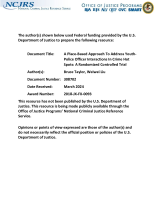Do the criminal histories of vacant properties matter? Evidence from demolition and rehab interventions in Cleveland, Ohio
Journal
Journal of Experimental Criminology
Date Published
September 2025
Agencies
NIJ-Sponsored
Publication Type
Research (Applied/Empirical)




